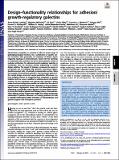Por favor, use este identificador para citar o enlazar a este item:
http://hdl.handle.net/10261/177498COMPARTIR / EXPORTAR:
 SHARE SHARE
 CORE
BASE CORE
BASE
|
|
| Visualizar otros formatos: MARC | Dublin Core | RDF | ORE | MODS | METS | DIDL | DATACITE | |

| Título: | Design–functionality relationships for adhesion/ growth-regulatory galectins |
Autor: | Ludwig, Anna-Kristin; Michalak, Malwina; Xiao, Qi; Gilles, Ulrich; Medrano, Francisco Javier CSIC ORCID ; Ma, Hanyue; FitzGerald, Forrest G.; Hasley, William D.; Melendez-Davila, Adriel; Liu, Matthew; Rahimi, Khosrow; Kostina, Nina Yu; Rodríguez Emmenegger, César; Möller, Martin; Lindner, Ingo; Kaltner, Herbert; Cudic, Mare; Reusch, Dietmar; Kopitz, Jürgen; Romero, Antonio CSIC ORCID ; Oscarson, Stefan; Klein, Michael L.; Gabius, Hans-Joachim; Percec, V. | Palabras clave: | Glycoconjugate Lectin Parasite Tumor |
Fecha de publicación: | 4-feb-2019 | Editor: | National Academy of Sciences (U.S.) | Citación: | Proceedings of the National Academy of Sciences of the United States of America 116(8) 2837-2842 (2019) | Resumen: | Glycan-lectin recognition is assumed to elicit its broad range of (patho)physiological functions via a combination of specific contact formation with generation of complexes of distinct signal-triggering topology on biomembranes. Faced with the challenge to understand why evolution has led to three particular modes of modular architecture for adhesion/growth-regulatory galectins in vertebrates, here we introduce protein engineering to enable design switches. The impact of changes is measured in assays on cell growth and on bridging fully synthetic nanovesicles (glycodendrimersomes) with a chemically programmable surface. Using the example of homodimeric galectin-1 and monomeric galectin-3, the mutual design conversion caused qualitative differences, i.e., from bridging effector to antagonist/from antagonist to growth inhibitor and vice versa. In addition to attaining proof-of-principle evidence for the hypothesis that chimera-type galectin-3 design makes functional antagonism possible, we underscore the value of versatile surface programming with a derivative of the pan-galectin ligand lactose. Aggregation assays with N,N′-diacetyllactosamine establishing a parasite-like surface signature revealed marked selectivity among the family of galectins and bridging potency of homodimers. These findings provide fundamental insights into design-functionality relationships of galectins. Moreover, our strategy generates the tools to identify biofunctional lattice formation on biomembranes and galectin-reagents with therapeutic potential. © 2019 National Academy of Sciences. | Descripción: | 6 p.-5 fig.-2 tab. | Versión del editor: | https://doi.org/10.1073/pnas.1813515116 | URI: | http://hdl.handle.net/10261/177498 | DOI: | 10.1073/pnas.1813515116 | ISSN: | 0027-8424 | E-ISSN: | 1091-6490 |
| Aparece en las colecciones: | (CIB) Artículos |
Ficheros en este ítem:
| Fichero | Descripción | Tamaño | Formato | |
|---|---|---|---|---|
| pnas_Ludwig_2019.pdf | 1,21 MB | Adobe PDF |  Visualizar/Abrir |
CORE Recommender
PubMed Central
Citations
31
checked on 10-abr-2024
SCOPUSTM
Citations
56
checked on 23-abr-2024
WEB OF SCIENCETM
Citations
54
checked on 22-feb-2024
Page view(s)
303
checked on 24-abr-2024
Download(s)
143
checked on 24-abr-2024

